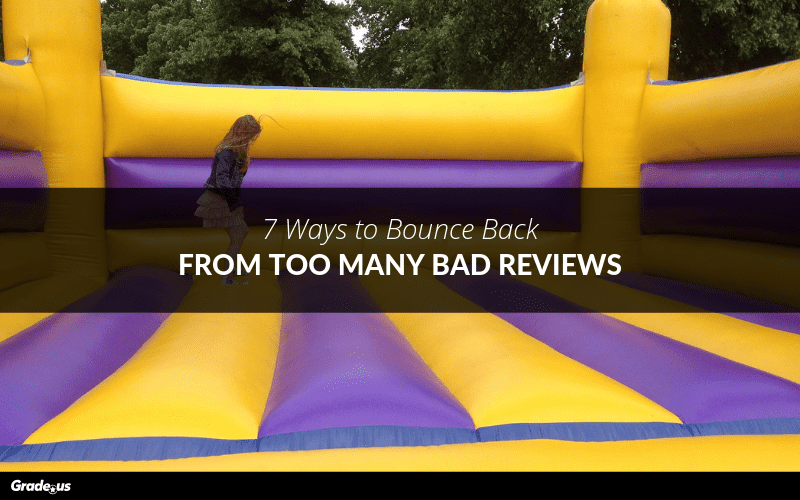Updated 9/23/2022
“0 stars!!!!
Piece of sh*t people working for piece of sh*t man who owns this lot and have a piece of sh*t app!” This company has 20 reviews; 19 of these are 1-star reviews from very angry customers.
Their complaints are legitimate.
Each of these customers was severely inconvenienced; they were treated horribly by the company they paid and then, to add to that suck salad, they were punished when they attempted to hold the company accountable.
See for yourself.
Read Aryelle D.‘s review of ParkJockey Miami on Yelp
Is it possible to bounce back from this?
It depends.
You can still bounce back, you can even continue to get business while you do it.
What’s the consequence of bad reviews?
What’s the customer impact of negative reviews? The data here is pretty straightforward.
- 19% of the reviews the average business receives are negative
- Employers with a bad reputation spending 10% more per hire (the average cost before bad reviews is $4,700)
- It takes roughly 40 positive customer experiences to undo the damage of a single negative review
- Negative reviews stop 40% of buyers from wanting to use a business
- Companies that make a concerted effort to improve their customer experience also see employee engagement rates go up by an average of 20%
What about the impact on search?
Research from Moz states that companies with bad reviews risk losing as many as:
- 21.9% of customers if you have just one negative review listed on page one of Google
- 44.1% of customers if you have two negative results
- 59.2%of customers with 3 negative results
- 69.9% of customers with 4 negative results
Check out this post if you’d like to calculate the impact negative reviews will have on your search rankings.
No surprise, the impact is terrible.
If the majority of the reviews in your review portfolio are negative, you’re going to lose traffic, visibility, customers, and revenue. Your conversion rates will take a significant dip. Ad costs, your cost per lead, and your return on ad spend will all take a turn for the worse.
It’s a tough hole to dig out of.
But that’s the question, isn’t it? How do you dig yourself out of a deep hole like that?
Step #01: Make sure your reviews are real
If you read my interview with Ben Fisher or Jason Brown, you know fake reviews are a problem. A big one. Still.
You also know there are entire weird conspiracies of review rings that try to tear some businesses down to build others up. And that there are clues that you (or, more likely, an expert like Fisher or Brown) can use to ferret out these reviews.
Every fake bad review you can get rid of is one less bad review to worry about.
Pinpointing the fakes also means you don’t spend time and energy responding to problems that aren’t really indicative of problems in your organization.
Step #02: Do these negative reviews violate policy?
You’ll want to go through the reviews in your portfolio carefully, looking for reviews that are:
- Not relevant to your business or location
- Has a clear conflict of interest
- Doesn’t focus on the reviewer’s own experience (i.e., politically motivated reviews)
- Is hateful, offensive, sexually explicit, or contains threats
- Violates privacy or confidentiality criteria
- Creates a legal issue
- Attempts to manipulate rankings on a particular review platform (e.g., TripAdvisor, Yelp)
Once you’ve flagged the offending reviews, report them to the appropriate review platform. Be sure to spell it out for company employees, making it easy for them to give you what you want. The easier it is for them to evaluate your claim, the easier it will be to get what you want.
Read through the review guidelines for each platform before reporting your reviews.
Here’s a shortlist for the big four.
Step #03: Use creative marketing to get new customers in the door
It’s time to get creative with your marketing. When you work for a small business, while you might be limited in marketing and advertising budget, you have more flexibility to get creating and try some tactics that would generate new customers. The more new people you see, the more chances you’ll get to earn great reviews and offset those bad ones.
In the home services industry? You may want to offer a great special on your GMB page.
Restaurant or hotel? Consider launching a fun event.
Doctor? Go to a health fair. Lawyer? Host an educational legal seminar at your local library.
Don’t fall prey to the idea that you’ve got bad reviews now, so you’re on your way out of business. That’s only true if you let it be true. You may have to work harder for a while, but you have options.
Obviously, if you take the time to do these things, be sure you blow these customers out of the water with how awesome your service is. Otherwise, you’ll just waste your time and your money.
Step #04: Use Your Sense of Humor
“Come in and try the worst meatball sandwich that one guy on Yelp ever had in his life.”
Well, now I want to know what that sub tastes like. Don’t you? Not only do I have to admire this restaurant owner’s sense of humor and moxie, but I bet the sandwich isn’t even that bad.
We all know some reviewers are just trolls, even if they are actual customers of the actual place. Might as well share a laugh about that with people who love you.
Even if some reviewers weren’t trolls, you just can’t please everyone all the time.
That’s a good thing.
If I look up a business and it doesn’t at least have a smattering of 1 and 2-star reviews, I wonder whether the rest of them are real.
So if you can’t find your sense of humor (or your business doesn’t really allow for snark), you can at least remind yourself having some negative reviews help you more than it hurts you.
Step #05: Make Sure All Your Customers See It
Michael Liner is a disability attorney in Cleveland, Ohio, who decided to publicize his 1-star review to his entire mailing list of clients and referral partners. His monthly newsletter goes to about 6,500 people.
“I wrote about how I turned the negative review into a positive learning experience for me. It was one of our most shared articles ever, and I received dozens of emails from people disagreeing with me being a ‘one-star’ lawyer. I even got a few people who left 5-star reviews.”
It’s a good strategy. It instantly demonstrates to people who do think highly of you that you’re willing to admit your mistakes and learn from them. And if it inspires some customers to publicly leap to your honor by leaving 5-star reviews of their own? You’ve just won.
Liner published the article on his website, too.
Step #06: Fix your business and let people know
Sometimes the issues are fixable. Like this restaurateur who got bad reviews about portion sizes and prices, so changed them. But he didn’t stop there. He also emailed every reviewer personally to let them know he’d made a shift. Invited them back to see if they liked the new offerings better.
No need to spend a whole lot of time here: every article about bad reviews beats the “just fix it already” drum. But in this case, the step where you’re using the same customers to tweak and fine-tune the offering into a 5-star one is a good impulse. Stronger and smarter than, say, just “deciding to provide better service.”
If you want customers to give you a second chance, you’ll need to permanently fix the problem. What specifically should you focus your attention on?
- The emotional weight: Your customers aren’t happy about how things went with you. They’re frustrated that things didn’t turn out the way they expected. They want you to acknowledge that and own your role in the outcome. Speak to the fears, concerns, objections, and complaints mentioned in these reviews.
- Your apology: This is a complicated issue, especially when it comes to legalities. You’ll need to walk a fine line here. Apologies aren’t created equal; you’ll need to apologize in a way that meets your customer’s needs. This could be accepting responsibility, expressing regret, requesting forgiveness, etc. You’ll need to own the problem but do it in a way that doesn’t endanger your company further.
- Fixing the problem: An apology isn’t enough. your customers want you to make amends. Correcting the order, issuing a refund, shipping a new product or service, or offering free vouchers – these are all ways to make amends. You’ll need to provide your customers with a solution that makes them whole. Don’t add insult to injury by going cheap. Do what it takes to make things right so the customer relationship can be restored.
- Explain for the future: Tell customers (a.) what happened, (b.) why it happened, and (c.) how your organization will prevent this problem from happening again. This is especially important for your review responses, customers and lurkers will want to see that you’ve taken steps to ensure this doesn’t happen to them.
If you ignore these issues, you’ll find that the next review they leave will compound the damage done to your business.
Step #07: Respond with a little heart
In one Hospitality.net article, author Doug Kennedy suggested most failures of service in the hospitality industry are really failures of heart.
“More specifically, I am referring to the failure to understand the true heart of hospitality, which is ‘caring about others as well as caring for others.'”
“When we care ‘for’ others, we provide the minimal requirements of a positive guest stay, the foundation of which is a clean, well-maintained ‘physical product,’ (the accommodation and public facilities), delivered promptly and efficiently. Yet when we care ‘about’ others, we understand the hospitality business is truly centered on personally providing ‘human travel experiences,’ which is why it is not called ‘the room rental industry.'”
Kennedy goes on to say that empathizing about the problem, providing validation, and apologizing is often about 100 times more powerful than simply “fixing” the problem. And while his article is laser-focused on the hospitality industry, I think it really applies to any industry.
But empathizing goes beyond (way beyond) “we’re sorry for your inconvenience.”
Or, “We’re sorry our service wasn’t up to its usual standards,” a response which tends to make me roll my eyes every time I read it. Dude, by the time you’ve made this response to ten different reviewers? The crap experience looks like it 100% is the usual standard. Don’t go there.
Angry customers tend to tell the entire story in their reviews, from start to finish. That gives you plenty of specific information to respond to and empathize with. Starting there, then moving on to solutions, is a powerful move.
Step #08: Develop a Talk Trigger
“Talk Triggers” comes from the book of the same name by Jay Baer and Daniel Lemin.
The idea is you deliberately bake something into your way of doing business that gives people, “something to talk about.”
Something intriguing. Something that makes people stop and go, “That’s really cool.” Something that inspires people to leave a review because it’s just different. Every business has to develop their own. You’ll have to exercise some creativity (and maybe read both interviews and the book) to really get a sense of how to do it. But if you can, bouncing back from bad reviews is almost an inevitability.
You can still bounce back from a portfolio of bad reviews
You can even continue to get business while you do it.
If the majority of the reviews in your review portfolio are negative, you’re going to lose traffic, visibility, customers, and revenue. That said, panicking is the worst mistake you can possibly make. Panicking is what causes business owners to lash out at people who write bad reviews.
To start suing.
It inspires them to create self-fulfilling prophecies by telling news outlets Yelp and Google and all the others are killing their business.
Yes, if you leave the situation unaddressed for too long, you could see your business enter a world of hurt. But it doesn’t have to be that way. Take a breath and start thinking about how you can turn the 1-star review to your advantage. It may just be easier than you think.










